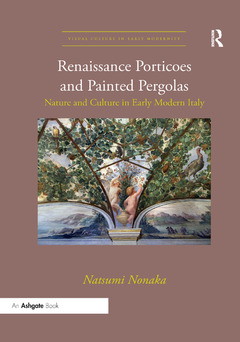Renaissance Porticoes and Painted Pergolas Nature and Culture in Early Modern Italy Visual Culture in Early Modernity Series
Auteur : Nonaka Natsumi

This book is the first study of the portico and its decorative program as a cultural phenomenon in Renaissance Italy. Focusing on a largely neglected group of porticoes decorated with painted pergolas that appeared in Rome and environs in the sixteenth and early seventeenth centuries, it tells the story of how an element of the garden?the pergola?became a pictorial topos in portico decoration, and evolved, hand in hand with its real cousin in the garden, into an object for cultural emulation among the educated patrons of early modern Rome. The liminality of both the portico and the pergola at the interface of architecture and garden is key to the interpretation of these architectural and painted forms, which rests on the intersecting frameworks of the classical tradition, natural history, and the cultural identity of the aristocracy. In the mediating space of the Renaissance portico, the illusionism pergola created an art gallery, a natural history museum, and a virtual garden where one could engage in leisurely strolls, learned conversations, appreciation of art, and scientific investigation, as well as extensive travel across time and space. The book proposes the interpretation that the illusionistic pergola was an artistic formula for the early modern perception of nature.
Table of Contents
Introduction
Chapter 1 Mediating Spaces: Portico, Loggia, and Pergola
Chapter 2 Classical Tradition and Vernacular Culture
Chapter 3 Visual Encyclopedia and Trellised Walkways
Chapter 4 Pictorial Fiction and Cultural Identity
Chapter 5 Wunderkammer and Trompe-l’Œil Garden
Chapter 6 Collecting Nature: Virtual Flora and Fauna
Epilogue
Appendix
Bibliography
Natsumi Nonaka received her Ph.D. in Architectural History from the University of Texas at Austin in 2012. Her specialization is art and architecture in early modern Italy. She taught architectural history at the University of Texas at Austin and is currently teaching art history at Montana State University.
Date de parution : 04-2019
17.4x24.6 cm
Date de parution : 03-2017
17.4x24.6 cm
Thèmes de Renaissance Porticoes and Painted Pergolas :
Mots-clés :
Illusionistic Pergolas; portico; Biodiversity Heritage Library; pergola; Villa Giulia; porch; Palazzo Altemps; colonnade; Villa Farnesina; gazebo; Semicircular Portico; arbor; Paul III; trellis; Vine Pergola; lattice; Julius III; Renaissance; Luca Ghini; early modern; Francisco De Hollanda; Italy; Raphael’s Workshop; Europe; Ancient Roman; Rome; Maarten Van Heemskerck; sixteenth century; Andrea Cesalpino; seventeenth century; Cut Flowers; garden; Pope Paul III; landscaping; Giardino Segreto; architecture; Cardinal Bibbiena; classical studies; Villa Lante; classical period; Accademia Dei Lincei; art; Jacques Androuet Du Cerceau; nature; Vault Decoration; Getty Research Institute; Piano Nobile



